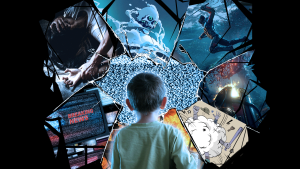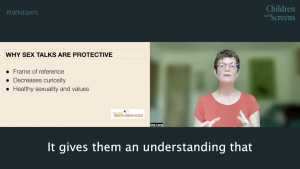
It has become increasingly common for images of violence to be shared across screens through the news and social media. Witnessing on-screen violence and traumatic events, particularly against innocent people and children, can generate a wide range of emotions: shock, outrage, fear, distress, powerlessness, sadness, and anger. Children, of course, are no exception. Though they may express their feelings differently, they may be experiencing big emotions due to exposure to violence online.
These events are never easy to discuss with your children or students; however, young people need help processing the images they have witnessed. Older children and teens will feel anxious about violent behavior, displacement of families, and its aftermath. Tweens and teens may also have questions about the lives being impacted through violent events. Specifically, children and teens might assume that this behavior enacted by adults is acceptable, and try to mimic similar violence or aggression. For others, it may leave them feeling helpless in the face of injustice and deter them from seeking out or doing what’s right in the future.
Children and Screens has put together 12 tips for how families can work through exposure to violence online.
Put Your Oxygen Mask on First
1. Be Careful With Curious Eyes and Ears
If you have young children, consider watching the news privately on your laptop or cell phone with headphones, or after they have gone to bed, to reduce the possibility of sights and sounds of violence from background TV. While it may seem harmless to keep the television news on in the background or in a room set apart from where children are playing, witnessing violence and civil unrest–especially when it impacts families and children–can be frightening and anxiety-producing.
2. Be Aware of Social Media Exposure
Coverage of violent events is no longer restricted to regularly scheduled news segments. Youth increasingly access their news on social media platforms, where violent images and videos can appear with little (or no) warning. Social media platforms continue to struggle with content moderation, too, meaning that extreme violent content shared with malicious intent can also be a risk.
During periods of high conflict, it might be helpful to sit with your teen and scroll through social media together. Talk about what you see and what it means. Discuss possible steps to block or filter certain content, and how to do so. Most importantly, encourage your teen to talk to you about anything they see that might be upsetting. Ultimately, you are the expert on your child and your family’s values, and you should work with your teen to determine how to stay connected safely and responsibly.
3. Make Space for Conversation
Be proactive, and start a conversation with your child in a comfortable time and place. While it might be tempting to protect your child from these events, depending on their exposure to other people and the scale of the event, it is likely that they may overhear or see something elsewhere. Starting the conversation early will let you introduce the issue on your terms, and will also let your child know that you are available if they have any concerns or questions that come up later.
Consider the age and maturity of your children or students when deciding what and how to share. One simple guideline is to follow their questions and let them steer the conversation. You might even start with open-ended questions to get a sense of what they already know. Promise to meet them where they are, provide answers suitable for their age and understanding, and assure them that if you don’t know something, you’ll discover it together.
Very young children need brief, simple information that should be balanced with reassurances of safety. Talk softly and calmly, using words they understand. As children get older, they may be more vocal in asking questions and sharing feelings. It may be helpful to talk about what is being done to help those in need. Adolescents in middle and high school may want to talk in more depth about the causes of violence and bigger issues around politics and society. Emphasize that adults are responsible for keeping them safe, but discuss concrete steps they can take to help, if interested. (See #11)
It might be helpful to have these conversations casually, while doing an activity together or during a drive, for example. Young children may have a hard time expressing emotions verbally, so using drawings or pictures can help.
Above all, emphasize that you’re there to support them and foster open lines of communication, making it clear that they can always approach you to discuss their concerns or share their feelings.
4. Correct Misinformation
In a world filled with information, it’s essential to help our children navigate it wisely. When discussing any conflict or witnessing violence online, encourage critical thinking. Teach them to verify facts, consider multiple perspectives, and ask questions. Encourage them to ask themselves questions about what they are watching and reading. For example, “Who made this?” “Who wrote this?” “Why might they have done so?” “What information is included?” “What might be missing?” (See “How to Help Kids (and Adults) Spot Misinformation Online”)
Correcting misinformation is not just about giving answers but empowering them to seek the truth. By fostering a curious and discerning mindset, we equip our children with the tools to sift through the noise and develop a deeper understanding of complex global issues.
5. Reassure Your Kids That They Are Safe
Each conversation you have about these events should begin and end with reassurance that your children and family are safe. It may help to provide context to the violence witnessed if far away, or to review the protections keeping your child safe at home and in their community. Discuss strategies for what they can do or who they can go to if they ever feel unsafe.
In addition, when you talk about these difficult matters, sit somewhere neutral and comfortable, but not in the room where your child sleeps. This will ensure that your child can return to the solace of their bedrooms.
Witnessing violence against others with similar identities, like children generally or those with similar racial, gender, religious, or cultural identities, can be particularly frightening. Be aware of these connections and be prepared to help the child process their feelings about them.
6. Maintain a Regular Schedule and Routine
7. Pay Attention
8. Give Your Kids a Break
9. Take a Screen Detox
10. Explain that Violence is Never the Answer
11. Get Involved
Older children and adolescents, especially, might be interested in taking action to help those in need or address broader issues. Taking effective action can be particularly helpful in addressing feelings of hopelessness, apathy, or frustration. Specific steps might look different based on the age and abilities of your child, but could include fundraising, attending a rally, volunteering, donating supplies, or getting involved in community activities and organizations focused on change. Help your child decide what action would be most meaningful to them and set a plan.
As online opportunities for engagement and activism increase, it is important to take time to teach your child essential online safety and citizenship skills. Discuss how they can engage with others online respectfully and safely, and remind them that posts are public and permanent.





